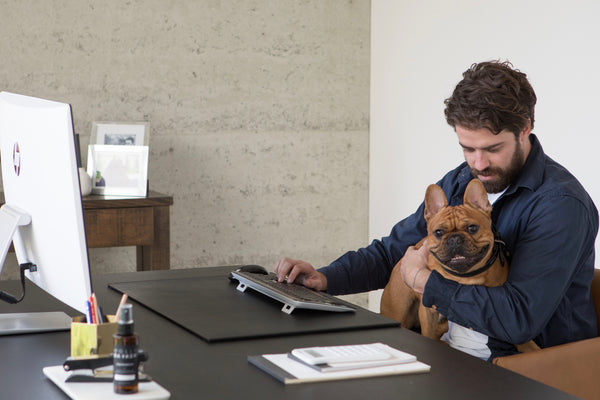How To Make The Transition Back to Work Easier On Your Dog

We spoke to Ian Shivers, a professional dog behaviour specialist and founder of Syndey’s Bondi Behaviourist to discuss ways we can make the transition back to work easier, and signs to look for if it's not going to plan.
Understand why it might be hard for them to adjust
“Dogs do really well when they have a routine. They know what to expect and what is expected of them” says Ian. So you can imagine after weeks or months of having someone around them to play with or constantly tell them what to do, they can become confused, anxious and bored when all of a sudden they are left alone with no instructions. Furthermore, prior to home isolation taking affect, dogs would sleep most of the day and feel rested and calm. But with family members home all day, we’ve been creating stimulants by patting them or even getting up to get a glass of water. Therefore our dogs periods of deep sleep have been upset. So it’s no wonder after a couple of months you may start to see a personality shift. Signs of anxiety or boredom to watch out for may include:
- Destructive behaviour like chewing door frames and furniture
- Escaping from the house or backyard
- Pacing
- Digging
- Loss of appetite
- Shivering
- Refusing to leave your side
- Having accidents indoors even though your pup is housebroken
One to two weeks prior to going back to work
The sooner you can start introducing pets to their new routine the better. Ian recommends “Start to introduce healthy degrees of separation. Start developing your dogs tolerance for being on his/her own. It’s not a case of pushing them away because that will cause more stress. Instead use the resources you already have available to you” including;
- Leave your dog inside while you go outside to hang out the washing or do some gardening
- When you feed your dog, put a barrier between you and your dog. For example feed them in another room or where you will be out of sight. Don’t leave them too long as this will cause panic and compound the issue.
- Get dressed as if you were leaving for work, and go pick up lunch or a coffee. Over the space of a couple fo days, gradually increase the time you are away
- Start rewarding them for periods of distance. Get them to sit on their bed, leave the room for a few seconds (gradually increasing the time) and give them a treat upon your return.
This last point is important to elaborate on. While treats are a great way to reinforce positive behaviour, don’t just give your dog a treat (or one specific treat) only when you leave. Otherwise they will associate this treat with you leaving…so mix it up.
Important Things To Consider
Avoid giving them treats or activities that will spike their adrenaline such as a ball that could end up under the counter, causing frustration if they can’t retrieve it. While it might distract them for a period of time, they will come away feeling stressed or amped up. Instead choose an item they can calmly suckly or lay on. While we want to keep our dog entertained, the idea of giving them an item when you leave is so they can pacify themselves and remain relaxed.
Leave your dog somewhere in the house where they will be safe. Make sure the space you leave them in is calm and doesn’t have access to stressors. - For example the front window. When a dog has access to a front window where they can see people passing by, they will be on high alert as a means of protecting themselves and their territory. So close the door to the front room so they don't feel the need to be on alert.
New toys may help with the adjustment as well. It will give them something exciting to look forward to and prevent boredom and loneliness. Treat balls filled with tasty snacks, lick mats, and interactive toys are all great ideas. But be sure you select options that will offer a distraction without causing over stimulation.
Furbo’s and Camera’s - These are great if you’re using them to serve your dog not yourself. For example, if you see your dog is anxious or stressed, go ahead and check in with them. Use a clam voice and give them a command they know such as “go to your bed”. It can give the dog clarity in a moment of uncertainty. Don’t use a high pitched or excited tone that will further stimulate them.
If you can see your dog is sleeping or calmly playing, just leave them be. This means they are coping well on their own and the last thing you want to do is rev them up only to leave them alone a minute later.
When Things Aren't Going To Plan
If despite your best efforts, your dog just isn’t adjusting to being home alone again (or maybe you have a new rescue that isn’t handling it well at all), and you feel like you could benefit from behavioural assistance, dog training may be a consideration. Not only can it help boost a dog’s confidence, but a trainer can help you work with your dog on counter-conditioning their anxiety response to being left alone, teaching them to at least tolerate it, even if it may never be something they’ll enjoy.
For extremely anxious dogs these suggestions may not be enough. If this is the case a consultation with your veterinarian may be the way to go. They will be able to prescribe medication or suggest other natural alternatives.
To find out how to choose the right dog toy for your dog, read our helpful blog.


